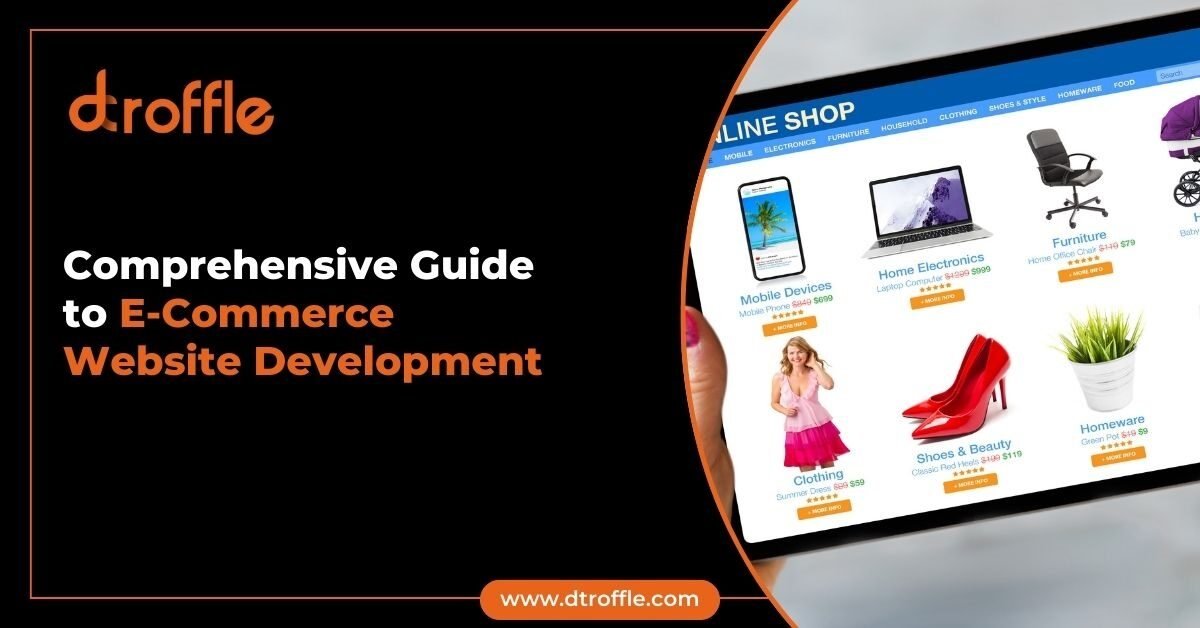Developing an effective e-commerce website is essential for businesses looking to sell products or services online. A well-designed e-commerce site can significantly enhance user experience, drive sales, and establish a strong online presence. This comprehensive guide covers the key aspects of e-commerce website development, ensuring that you create a site that meets both your business needs and customer expectations.
1. E-commerce Basics
Overview: Understanding the fundamentals of e-commerce is the first step in building a successful online store. E-commerce involves buying and selling products or services over the Internet, and it requires careful planning and execution.
Key Considerations:
- Business Model: Define whether you’ll operate a Business-to-Consumer (B2C), Business-to-Business (B2B), or Consumer-to-Consumer (C2C) model.
- Product Catalog: Determine the range of products or services you’ll offer and how they’ll be categorized.
- Payment Processing: Choose secure and reliable payment gateways to handle transactions.
Benefits:
- A clear understanding of business objectives and models.
- Better planning and alignment with market needs.
2. Selecting the Right Platform
Overview: Choosing the right e-commerce platform is crucial for your website’s functionality and scalability. Different platforms offer various features and capabilities, so it’s important to select one that suits your business requirements.
Key Options:
- Shopify: Known for its user-friendly interface and extensive app marketplace.
- Magento: Offers advanced customization and scalability for larger businesses.
- WooCommerce: Ideal for businesses using WordPress, with flexible features and plugins.
- BigCommerce: Provides robust built-in features and integration options.
Benefits:
- Optimal platform choice based on business size, budget, and needs.
- Enhanced functionality and ease of use.
3. Designing an Engaging User Experience (UX)
Overview: An engaging user experience is key to retaining customers and driving sales. Effective UX design involves creating a website that is easy to navigate, visually appealing, and responsive across devices.
Key Design Elements:
- Navigation: Ensure intuitive and user-friendly navigation with clear menus and search functionality.
- Responsive Design: Optimize the site for mobile and tablet users.
- Visual Appeal: Use high-quality images, consistent branding, and an attractive layout.
- Accessibility: Make the site accessible to users with disabilities.
Benefits:
- Improved customer satisfaction and engagement.
- Higher conversion rates and reduced bounce rates.
4. Implementing Essential Features
Overview: Integrating essential features into your e-commerce site enhances functionality and user experience. These features are crucial for managing products, processing transactions, and providing customer support.
Key Features:
- Product Pages: Include detailed descriptions, high-resolution images, and reviews.
- Shopping Cart: Provide a seamless and secure checkout process.
- Search and Filters: Implement search functionality and product filters for easy navigation.
- Customer Accounts: Allow users to create accounts for tracking orders and managing preferences.
Benefits:
- Enhanced functionality and ease of use for customers.
- Efficient management of products and transactions.
5. Optimizing for Performance and SEO
Overview: Performance and search engine optimization (SEO) are critical for driving traffic and ensuring a smooth user experience. Optimizing your e-commerce site helps it rank higher in search engines and load quickly.
Optimization Strategies:
- Speed: Optimize images, use content delivery networks (CDNs), and minimize code to improve load times.
- SEO: Incorporate relevant keywords, meta tags, and alt text for images.
- Mobile Optimization: Ensure the site performs well on mobile devices.
- Analytics: Use tools like Google Analytics to monitor performance and make data-driven improvements.
Benefits:
- Improved search engine rankings and visibility.
- Faster load times and better user experience.
6. Test and Launch Your Site
Overview: Thorough testing is essential before launching your e-commerce site. Testing ensures that all features work correctly and that the site is free of bugs or issues.
Testing Checklist:
- Functionality: Test all features, including the shopping cart, payment gateway, and search functionality.
- Compatibility: Ensure the site works across different browsers and devices.
- Performance: Check load times and address any performance issues.
- Security: Verify that the site has SSL certificates and secure payment processing.
Benefits:
- A smooth and error-free launch.
- Enhanced user experience and security.
7. Post-Launch Maintenance and Support
Overview: Ongoing maintenance and support are crucial for keeping your e-commerce site running smoothly and addressing any issues that arise after launch.
Maintenance Tasks:
- Regular Updates: Keep the site and its components updated to ensure security and functionality.
- Backup: Perform regular backups to protect data.
- Monitoring: Continuously monitor site performance, security, and user feedback.
- Support: Provide customer support to address any issues or questions.
Benefits:
- Continuous site performance and security.
- Ongoing customer satisfaction and support.
Conclusion
Building a successful e-commerce website involves a strategic approach to planning, design, implementation, and maintenance. By understanding e-commerce basics, selecting the right platform, designing an engaging UX, implementing essential features, optimizing for performance and SEO, testing thoroughly, and maintaining the site post-launch, you can create a robust online store that meets your business needs and delights your customers. For expert assistance in developing your e-commerce site, consider partnering with an E-Commerce Website Development Company In Agra to ensure a high-quality and effective online presence.








